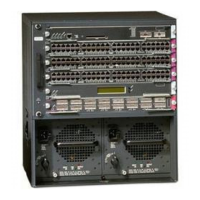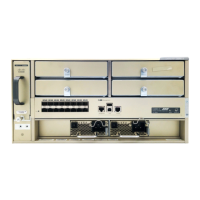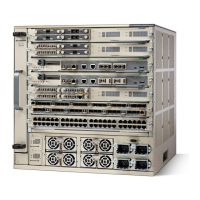9-2
Catalyst 6500 Series Content Switching Module Configuration Note
OL-4612-01
Chapter 9 Configuring Health Monitoring
Configuring Probes for Health Monitoring
• Passive HTTP error code checking (in-band response parsing)—The CSM parses HTTP return codes
and watches for codes such as “service unavailable” so that it can take a server out of service. Passive
HTTP error code checking has a small impact on session performance.
To set up a probe, you must configure it by naming the probe and specifying the probe type while in
probe submode.
After configuring a probe, you must associate it with a server farm for the probe to take effect. All servers
in the server farm receive probes of the probe types that are associated with that server farm. You can
associate one or more probe types with a server farm.
If you assign a port number when configuring either the real server or the virtual server you do not need
to specify a port number when you configure a probe. The probe inherits the port number from the real
or virtual server configuration.
You can override the real server’s and virtual server’s port information by explicitly specifying a port to
probe in the health probe configuration using the optional health probe port feature. This feature allows
you to set a port for use by the health probes when no port is specified either in the real server or virtual
server.
After you configure a probe, associate single or multiple probes with a server farm. All servers in the
server farm receive probes of the probe types that are associated with that pool.
Note If you associate a probe of a particular type with a server farm containing real servers that are not running
the corresponding service, the real servers send error messages when they receive a probe of that type.
This action causes the CSM to place the real server in a failed state and disable the real server from the
server farm.
To specify a probe type and name, perform this task:
Command Purpose
Step 1
Router(config-module-csm)#
probe probe-name {http | icmp
| telnet | tcp | ftp | smtp |
dns | kal-ap-upd}
Specifies a probe type and a name
1
2
:
• probe-name is the name of the probe being configured; it has a
character string of up to 15 characters.
• http creates an HTTP probe with a default configuration.
• icmp creates an ICMP probe with a default configuration.
• telnet creates a Telnet probe with a default configuration.
• tcp creates a TCP probe with a default configuration.
• ftp creates an FTP probe with a default configuration.
• smtp creates an SMTP probe with a default configuration.
• dns creates a DNS probe with a default configuration.
• kal-ap-upd creates a GSLB target probe.
1. The no form of this command removes the probe type from the configuration.
Step 2
Router(config-slb-probe-tcp)#
port
port-number: 1-MAXUSHORT
Configures an optional port for a probe
3
.
Step 3
Router# show module csm
slot
probe
Displays all probes and their configuration.
Step 4
Router# show module csm
slot
tech-support probe
Displays probe statistics.

